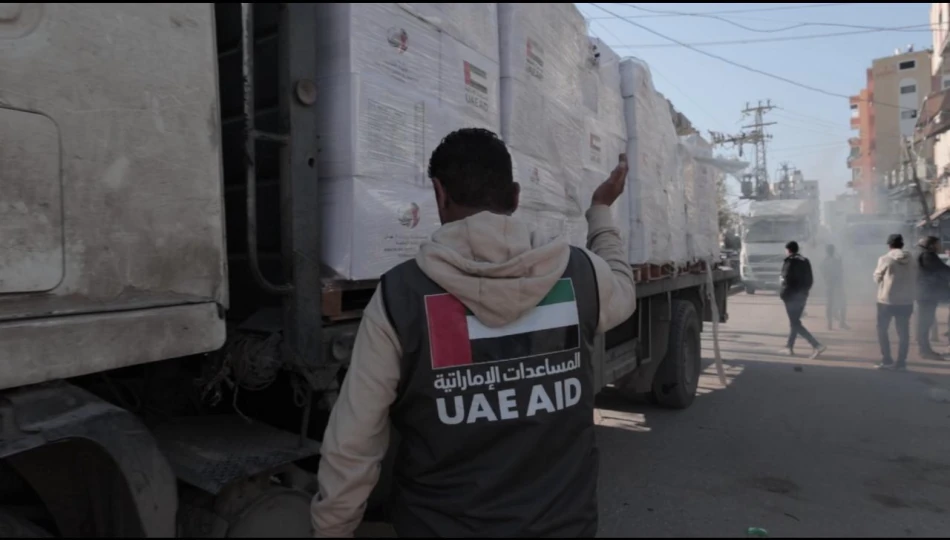
UAE Launches Largest Desalination Project, Supplying Water from Egypt to Southern Gaza
UAE Launches Major Water Pipeline Project to Serve 600,000 Gaza Residents
The United Arab Emirates has begun construction of the largest water pipeline project of its kind to supply desalinated water from Egypt to southern Gaza, addressing a critical humanitarian crisis in the besieged territory. The 6.7-kilometer pipeline will serve 600,000 displaced residents with 15 liters of clean water per person daily, marking a significant escalation in Gulf humanitarian intervention amid ongoing regional tensions.
Infrastructure Details and Scope
The ambitious project involves installing a 315-millimeter water transmission line connecting a UAE-built desalination plant on the Egyptian side to displacement areas between Khan Younis and Rafah. Announced during a press conference at the Coastal Municipalities Water Utility headquarters in Deir al-Balah, the initiative represents the UAE's most substantial water infrastructure investment in Gaza to date.
The pipeline addresses a dire situation where more than 80% of Gaza's water facilities have been destroyed during the current conflict. With Gaza's population of 2.3 million facing severe water shortages, this project could provide relief to roughly a quarter of the territory's residents.
Strategic Humanitarian Positioning
Sharif al-Nayrab, media spokesperson for Operation "Gallant Knight 3" in Gaza, emphasized that the project extends beyond emergency response. "This is not merely an urgent response to Gaza's water crisis, but an extension of the UAE's consistent approach to supporting the Palestinian people," he stated.
The UAE's involvement reflects a broader Gulf strategy of humanitarian diplomacy, similar to approaches taken by Qatar and Kuwait in previous regional crises. Unlike traditional aid distribution, this infrastructure project creates lasting capacity that could serve Gaza's population long after immediate crisis needs are met.
Regional Implications and Precedent
The cross-border water project establishes a significant precedent for regional cooperation in humanitarian infrastructure. By utilizing Egyptian territory to serve Gaza's population, the UAE has effectively created a new model for circumventing geographical and political constraints in aid delivery.
This approach mirrors successful infrastructure diplomacy seen in other contexts, such as China's Belt and Road Initiative or the UAE's own port investments across the Middle East and Africa. However, the Gaza project operates under unique humanitarian imperatives that distinguish it from commercial infrastructure ventures.
Technical and Logistical Challenges
Engineer Omar Shtat, Deputy Director General of the Coastal Municipalities Water Utility for Technical Affairs, acknowledged the complex operational environment. The project must navigate destroyed infrastructure, ongoing security concerns, and the challenge of maintaining water quality across the 6.7-kilometer pipeline.
The daily provision of 15 liters per person, while below World Health Organization recommendations of 20 liters minimum, represents a substantial improvement over current conditions where many Gaza residents access less than 3 liters daily.
Broader Humanitarian Strategy
Civil society representative Khalil Abu Shamala highlighted how this water project integrates with the UAE's comprehensive humanitarian portfolio in Gaza, including previous desalination plants, well drilling, and network maintenance. This systematic approach suggests long-term strategic thinking rather than reactive crisis management.
The project's success could influence future humanitarian infrastructure investments in conflict zones, potentially encouraging other Gulf states to pursue similar large-scale interventions. For international donors and humanitarian organizations, the UAE model demonstrates how substantial infrastructure investment can complement traditional aid distribution methods.
As Operation "Gallant Knight 3" continues expanding its humanitarian footprint, this water pipeline project may prove to be a defining example of how regional powers can leverage infrastructure development to address humanitarian crises while building lasting diplomatic influence.
Most Viewed News

 Sara Khaled
Sara Khaled






